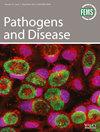Expression of a peroxiredoxin–glutaredoxin by Haemophilus influenzae in biofilms and during human respiratory tract infection
Abstract
Evidence is mounting that nontypeable Haemophilus influenzae grows as a biofilm in the middle ear of children with otitis media and the airways of adults with chronic obstructive pulmonary disease. To begin to assess antigens expressed by H. influenzae in biofilms, cell envelopes of bacteria grown as a biofilm were compared to those grown planktonically. A ∼30 kDa peroxiredoxin–glutaredoxin was present in greater abundance during growth in biofilms. Mutants deficient in expression of peroxiredoxin–glutaredoxin were constructed by homologous recombination in four clinical isolates. The mutants showed a 25–50% reduction in biofilm formation compared to the corresponding parent strains. To study in vivo expression of peroxiredoxin–glutaredoxin during human respiratory tract infection, paired pre- and post-exacerbation serum from adults with chronic obstructive pulmonary disease and H. influenzae in sputum were assayed using an enzyme-linked immunosorbent assay and purified recombinant peroxiredoxin–glutaredoxin. Eight from 18 (44.4%) paired serum samples showed a significant increase in antibody to peroxiredoxin–glutaredoxin from pre- to post-infection. These results indicate that (1) peroxiredoxin–glutaredoxin is present in greater abundance in H. influenzae biofilms compared to planktonically grown bacteria; (2) peroxiredoxin–glutaredoxin is involved in biofilm formation by H. influenzae and the degree of involvement varies among strains; and (3) peroxiredoxin–glutaredoxin is expressed by H. influenzae during infection of the human respiratory tract and is recognized by the human immune system.

 求助内容:
求助内容: 应助结果提醒方式:
应助结果提醒方式:


